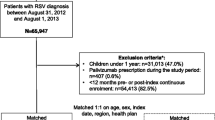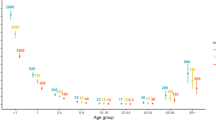Abstract
Objective: To determine the impact of respiratory syncytial virus (RSV) infection on healthcare resource use and costs in the US from the third-party payer perspective.
Design: The study retrospectively analysed cross-sectional medical encounter data from three federally funded databases that comprise nationally representative samples of hospital inpatient stays, physician office visits and visits to hospital outpatient departments and emergency rooms.
Methods: Identification of RSV infection-related medical encounters was based on the occurrence of RSV-specific International Classification of Diseases (9th Edition)-Clinical Modification diagnosis codes (079.6, 466.11, 480.1) as principal discharge diagnoses or the assumption that 10–15% of all otitis media visits were due to RSV infection. Outpatient drug costs were estimated based on average wholesale price, and physician fees and test/procedure costs were estimated based on prevailing national fees. Inpatient costs were estimated from total billed charges using a cost-to-charge ratio of 0.53.
Results: In 2000, nearly 98% of RSV infection-related hospitalisations occurred in children <5 years old. There were approximately 86 000 hospitalisations, 1.7 million office visits, 402 000 emergency room visits and 236 000 hospital outpatient visits for children <5 years old that were attributable to RSV infection. Total annual direct medical costs for all RSV infection-related hospitalisations ($US394 million) and other medical encounters ($US258 million) for children <5 years old were estimated at $US652 million in 2000. Otitis media was a major cost driver for physician visits. RSV infection-related hospitalisations increased from 1993 to 2000, but average costs per hospitalisation were relatively stable.
Conclusion: Treatment of RSV infection-related illness represents a significant healthcare burden in the US. The economic impact of ambulatory care for RSV infection-related illness could be as important as that for RSV infection-related hospitalisation.






Similar content being viewed by others
Notes
The code 466.11 was not available prior to 1996. Estimates based on ICD-9-CM code 466.1 (acute bronchiolitis) for years 1993–1995, with adjustment to reflect the proportion of hospitalisations in the period 1996–2000 that had a code of 466.11 (versus 466.19).
The documentation for the NAMCS and NHAMCS states that estimates of visit characteristics (e.g. age, gender, types of drugs prescribed) based on a sample size of <30 visit records are not reliable. Given that the number of visit records in each database with RSV infection-specific diagnoses (i.e. 079.6, 466.11, 4801.) was <30, RSV infection-related costs were estimated based on resource use obtained from records with a diagnosis of 466.1 (acute bronchiolitis). It was assumed that visits with this diagnosis would have similar resource use patterns compared with the visits that recorded RSV-infection specific diagnoses.
References
Hall CB, McCarthy CA. Respiratory syncytial virus. In: Mandell GL, Bennett JE, Dolin R, editors. Principles and practice of infectious diseases. 5th ed. New York: Churchill Livingstone, 2000: 1782–801
Hall CB. Respiratory syncytial virus and parainfluenza virus. N Engl J Med 2001; 344: 1917–28
Holberg CJ, Wright AL, Martinez FD, et al. Risk factors for respiratory syncytial virus-associated lower respiratory illness in the first year of life. Am J Epidemiol 1991; 133: 1135–51
Boyce TG, Mellen BG, Mitchel Jr EF, et al. Rates of hospitalization for respiratory syncytial virus infection among children in Medicaid. J Pediatr 2000; 137: 865–70
Anderson LJ. Respiratory syncytial virus vaccines for otitis media. Vaccine 2001; 19: S59–65
Pitkaranta A, Virolainen A, Jero J, et al. Detection of rhinovirus, respiratory syncytial virus, and coronavirus infections in acute otitis media by reverse transcriptase polymerase chain reaction. Pediatrics 1998; 102: 291–5
Vesa S, Kleemola M, Blomqvist S, et al. Epidemiology of documented viral respiratory infections and acute otitis media in a cohort of children followed from two to twenty-four months of age. Pediatr Infect Dis J 2001; 20: 574–81
American Academy of Pediatrics, Committee on Infectious Diseases and Committee on Fetus and Newborn. Prevention of respiratory syncytial virus infections: indications for the use of palivizumab and update on the use of RSV-IGIV. Pediatrics 1998; 102: 1211–6
Stang P. The economic burden of respiratory syncytial virusassociated bronchiolitis hospitalizations. Arch Pediatr Adolesc Med 2001; 155: 95–6
Howard TS, Hoffman LH, Slang PE, et al. Respiratory syncytial virus pneumonia in the hospital setting: length of stay, charges, and mortality. J Pediatr 2000; 137: 227–32
Leader S, Kohlhase K. Respiratory syncytial virus-coded pediatric hospitalizations, 1997 to 1999. Pediatr Infect Dis J 2002; 21 (7): 629–32
Center for Medicare and Medicaid Services (CMS). Data on hospitals’ cost-to-charge ratios. CMS public use files [online]. Available from URL: blip: //cms.hhs.gov/providers/ pufdownload/default.asp. [Accessed 2002 Sep 23]
US Bureau of Labor Statistics. Consumer price index [database online]. All urban consumers, US city average, medical care. Available from URL: blip: //146.142.4.24/cgi-bin/ surveymost?.cu. [Accessed 2002 Jul 31]
2002 Drug topics© RED BOOK©. Montvale (NJ): Medical Economics, 2002
Physicians fee & coding guide (a comprehensive fee & coding reference). Augusta (GA): HealthCare Consultants of America Inc., 2002
Kim HW, Arrobio JO, Brandt CD, et al. Epidemiology of respiratory syncytial virus infection in Washington, DC: I. importance of the virus in different respiratory tract disease syndromes and temporal distribution of infection. Am J Epidemiol 1973; 98: 216–25
Shay DK, Holman RC, Newman RD, et al. Bronchiolitisassociated hospitalizations among US children, 1980–1996. JAMA 1999; 282: 1440–6
Bredenberg HK, Graham BS. Hospitalization costs of respiratory syncytial virus infection. Pediatr Infect Dis J 2001; 20: 1100–1
Stevens TP, Sinkin RA, Hall CB, et al. Respiratory syncytial virus and premature infants born at 32 weeks’ gestation or earlier: hospitalization and economic implications of prophylaxis. Arch Pediatr Adolesc Med 2000; 154: 55–61
Lofland III, Touch SM, O’Connor JP, et al. Palivizumab for respiratory syncytial virus prophylaxis in high-risk infants: a cost-effectiveness analysis. Clin Ther 2000; 22 (11): 1357–69
Langley JM, Wang EEL, Law III, et al. Economic evaluation of respiratory syncytial virus infection in Canadian children: a Pediatric Investigators Collaborative Network on Infections in Canada (PICNIC) study. J Pediatr 1997; 131: 113–7
Heikkinen T. The role of respiratory viruses in otitis media. Vaccine 2001; 19: S51–5
Han LL, Alexander JP, Anderson LJ. Respiratory syncytial virus pneumonia among the elderly: an assessment of disease burden. J Infect Dis 1999; 179: 25–30
24. Martinez FD. Respiratory syncytial virus bronchiolitis and the pathogenesis of childhood asthma. Pediatr Infect Dis 12003; 22 (2 Suppl.): S76–82
Sigurs N. Epidemiologic and clinical evidence of a respiratory syncytial virus-reactive airway disease link. Am J Respir Crit Care Med 2001; 163: S2–6
Acknowledgements
Larry Liu is now employed at Pfizer.
This work was funded by Wyeth Research. The authors have no conflicts of interest that are directly relevant to the content of this study.
Author information
Authors and Affiliations
Corresponding author
Rights and permissions
About this article
Cite this article
Paramore, L.C., Ciuryla, V., Ciesla, G. et al. Economic Impact of Respiratory Syncytial Virus-Related Illness in the US. PharmacoEconomics 22, 275–284 (2004). https://doi.org/10.2165/00019053-200422050-00001
Published:
Issue Date:
DOI: https://doi.org/10.2165/00019053-200422050-00001




